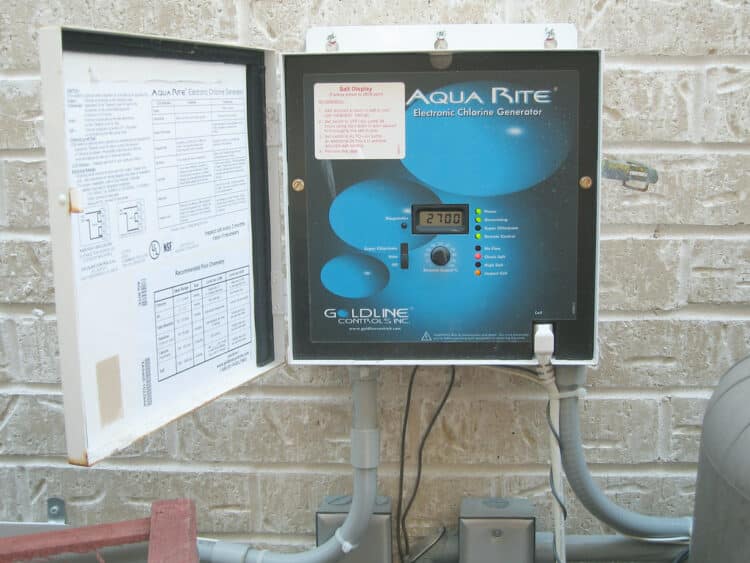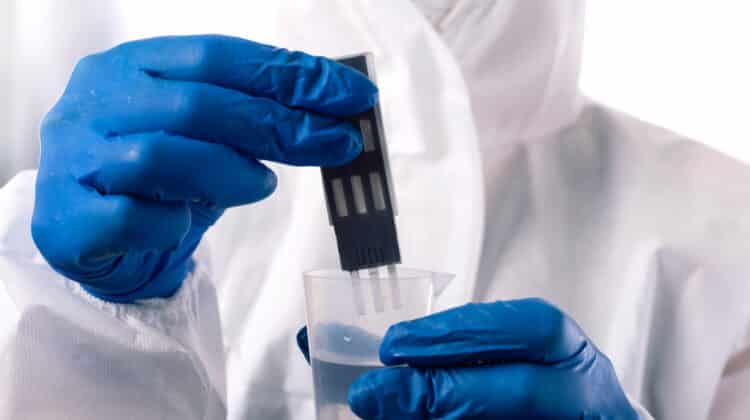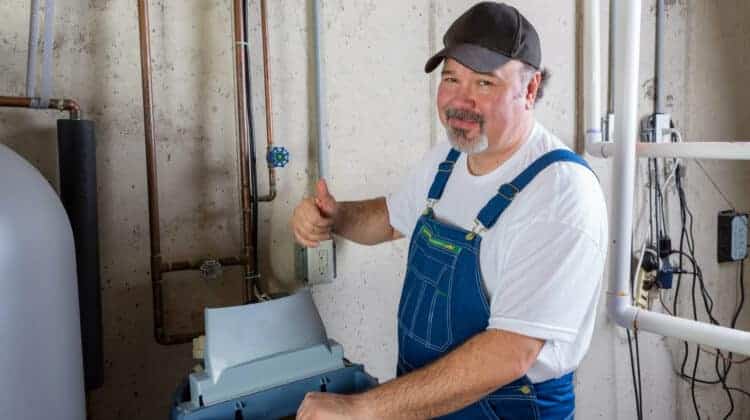
You have hard water. Dealing with the problems of hard water is not easy. It creates so many issues. And finding a solution is no less complicated. The good news is there is a solution. To get rid of your hard water problems, you need a water softener. But even that is not as simple as it sounds. There are quite a few factors to consider. One of them is finding the right water softener size. I’ve asked myself this question too. What size water softener do I need?
Only the right size water softener will improve the quality of your water and life.
You might think that walking into a home improvement store and asking how big of a softener do I need is all it takes. But, it is not as simple as that.
There is a process to choosing a water softener size that is suitable for your hard water situation.
Our water softener size guide will help you through this process.
First, there are a few key things you need to know.
Table of Contents
Why You Need The Right Sized Softener
Buying a water softener that is the wrong size is only going to disappoint you. If you get one that is too small, you may experience problems with the flow rate of your water.
The workload to soften water may also be too much for your water softener. Because of that, it may not last as long as it should. A water softener that is too small will also not regenerate often enough. That means, after spending so much money, you will continue to have water hardness issues.
Buying a water softener that is too big is also ineffective for a couple of reasons. The first reason is that you will waste a lot of water. And that will only hike up your water bill.
The second reason is that regeneration or cleaning will not happen on time. That means you will continue to experience those pesky hard water problems.
What’s the solution? Figuring out how to size your water softener is the way to go.
So, how do you know what size water softener you need? Start with capacity.
Softener Capacity Calculation
Most softeners have these softening capabilities.
- 24,000-grain capacity
- 30,000- grain capacity
- 32,000-grain capacity
- 48,000-grain capacity
- 64,000-grain capacity
But some go all the way up to 110,000-grain capacity. Most households do not need a softener that size.
A typical water softener with a 32,000 to 33,000-grain capacity will do for an average-sized family. But that family has to have average hard water problems. A home with more people, faucets, appliances that use water, and so on may need something larger.
The number of people in your household is essential to choosing a water softener size. That number lets you know how many gallons of water a softener needs to treat in a day.
In every gallon of water that your house uses, there are grains of hardness. And that is what you need a water softener to treat. So how do you use the size of a family to determine water softener sizes to fit a household?
You need to know how many gallons of water that flows through your pipes each day. Here is what you need to do to find that number.
Multiply how many people are in your house by the average amount of water each one uses daily. The national average of water use per person falls at around 70 gallons.
So let’s say you have five persons living at home. Four multiplied by 70 gives you a total of 350 gallons of water daily.
Take that 350 and multiply it by the grains of hardness in your water. So let’s imagine your water hardness level is 10.
350 multiplied by 10 gives you a total of 3500. The number you get is how many grains you need a water softener to get rid of each day.
Now, last but not least, multiply that number by how many days there are in the week. Your total is 24,500.
Water softeners have cleaning cycles that kick in at least once a week. So, every week a family of four needs a water softener to clean at 22,500 grains of minerals from their water.
The next step to figuring out how to properly size a home water softener is knowing how hard your water is.
Water Hardness Levels
The level of hardness of your water will let you know what water softener grain capacity you need to get. Now I’ve mentioned grains and grain capacity before. But we will get to the meaning of that in a bit.
But first, let’s take a closer look at the levels of water hardness.
Magnesium and calcium compounds, along with some metals, are what cause hard water.
The level of hardness in your water results from how many of these minerals and metals are in it. In water hardness, these minerals and metals are referred to as grains.
Grains are measured in
- per gallon (GPG)
- Milligrams in every liter (mg/L)
- Parts in every million (ppm)
You can also convert one unit of measurement to another. If you want to convert PPm or mg/L to grains, divide your hardness test reading by 17.1.
If there is iron in your water, add another 5 grains for each PPM or mg/L of iron.
Water Hardness Measurements
Water ranges from extremely soft to extremely hard, with other levels between.
-
- Water that is extremely soft
0 GPG/mg/l or ppm. Households with 0 GPG do not need water softeners.
-
- Water that is slightly soft
1-2 GPG, which is equal to 0-16 mg/L or ppm. Homes with this level of softness do not need water softeners either.
-
- Soft Water
3-5 GPG, which is equal to 16.1 to 60 mg/L or ppm. Homes with a GPG of 5 and higher need water softeners.
-
- Water that is a bit hard
6-8 GPG, which is equal to 60.1 to 120 mg/L or ppm
-
- Hard water
9-11 GPG, which is equal to 120 to 180 mg/L or ppm
-
- Water that is very hard
12-14 GPG, which is equal to 181 to 240 mg/L or ppm
-
- Water that is extremely hard
Water hardness of 15 GPG or higher. 15 GPG and above is equal to 240 mg/L or ppm or more.
There are two accurate ways to find out the hardness degree of your water. If you are a city water customer, you can call or check online for this information. Or you can use a water hardness measuring kit to test your water supply at home.
Water hardness measuring kits come with instructions on how to complete the test. There may be a few variations depending on the manufacturer of the test. But water hardness tests give accurate results. They are quick and easy to use.
What Is Water Softener Grain Capacity?
Before we get to how to determine what size water softener you need, let’s deal with grain capacity.
All water softeners are not created equal. They come with different capabilities to soften water. One of those capabilities is grain capacity.
Grain capacity means how much hardness a softener can remove from your water before you need to clean it. You may see that the cleaning cycle has the name regeneration.
Grain capacity is also part of the system you use to know what size water softener to get.
The water softener you buy should have the grain capacity to treat all the water your household uses in a day. We already discussed the levels of water hardness.
You have all this information on how to determine what size water softener you need. It is time to
Here is a guide of what grain water softener you need for various size households.
Water Softener Sizing Guide.
If you are wondering how big should my water softener be, this guide will help you. To get it right, you still need to know the number of people in your house and the hardness of your water.
Which scenario below matches your hard water situation? Use the guide to help you find the right water softener size.
- 0 – 3,500 grains per day needs a softener capacity of 24,000 grains.
- 3,501 – 4,500 grains per day needs a softener capacity of 32,000 grains.
- 4,501 – 5,750 grains per day needs a softner capacity of 40,000 grains.
- 5,751 – 6,850 grains per day needs a softener capacity of 48,000 grains.
Keep in mind that these are ballpark figures. The level of hardness in your water and how many gallons of it you use a day may affect these numbers. So, you should make your softener capacity calculation as accurate as possible.
You can take water softener calculation of capacity one step further.
Salt And Water Efficiency
What makes a water softener efficient? It has to do with more than just softening water. Efficiency in water softeners also measures the amount of salt and water it uses to do the job. In this regard, some water softeners are better to buy than others.
Let me explain. Water softeners use salt and water in the regeneration or cleaning cycle. Efficient softeners measure the number of grains each pound of salt cleans.
Ideal efficiency puts salt use at 3,350 grains removed for every pound of salt used for regeneration. For states like California, the efficiency marker is a little higher.
Likewise, ideal efficiency puts water use at five gallons in the regeneration cycle. That five gallons must remove at least one thousand of the grains that cause water hardness.
What does this have to do with water softener sizing? I’ll tell you. It all goes back to capacity. A water softener with the ability to remove 24,000 grains has 0.75 cubic measure or feet of resin. That amount of resin needs 27 pounds of salt for regeneration one cycle. That’s a lot of salt to spend on.
A softener system with the ability to remove 32,000 grains has one cubic measure or feet of resin. And that amount of resin needs 36 lbs of salt for one regeneration cycle.
But, here’s the kicker. You can use 6 lbs of salt to regenerate 20,000 grains in a system with a 32,000-grain capacity.
A softener with a 32,000-grain capacity is more costly than a 24,000-grain capacity system. But you will use a lot less salt, which is better for your pocket and the environment.
So, when choosing water softener size, do not only look at the softener grain capacity. If you want to be surer, you can also check salt and water efficiency for softener size calculation. Look at the salt efficiency and water efficiency per cubic foot of resin.
Resin Quantity
Resin beads in your water softener are what removes the minerals that make your water hard. The salt in your water softener is for cleaning the minerals the cling to resin beads away. So the number of these beads in your system affects salt and water efficiency. The more beads there are, the greater the softening capabilities. But that could also mean that you use a lot more salt and water if you are not vigilant.
Resin beads unit of measurement is cubic feet.
These capacity options list efficient levels of water softeners. That you can make the best choice. These numbers may be off by a small amount depending on manufacturers.
- 0.75 Cu ft of resin removes 15,000 grains during the regeneration cycle.
- 1.0 Cu ft of resin removes 24,000 grains during the regeneration cycle.
- 1.5 Cu ft of resin removes 32,000 grains during the regeneration cycle.
- 2.0 Cu ft of resin removes 40,000 grains during the regeneration cycle.
- 3.0 Cu ft of resin removes 60,000 grains during the regeneration cycle.
- 4.0 Cu ft of resin removes 80,000 grains during the regeneration cycle.
Here is a calculation example for a home of five with a hardness of 10gpd to help you. Use this guide to help you do softener calculation capacity for your household.
5 X 70 gpd = 350 gpd
350 gpd X 10 the ten grains = 3500 grains every day
1 cu ft @ 24,000 grains / 3500 = regeneration in every 6.8 days
1.5 cubic ft. @ 32,000 grains / 3500 = regeneration in every 9 days.
2.0 cubic ft. @ 40,000 grains / 3500 = regeneration in every 11 days.
Your ideal choice for a family in this situation is in a 1 cu ft unit that takes about 7 days before it needs to regenerate.
Conclusion
Finding a water softener that can meet your needs and budget is not simple. And you might be tempted to wing it. But, guesswork is not the best idea when choosing a water softener.
The wrong size water softener may disappoint and frustrate you. You run the risk of having to continue dealing with hard water. There is also the threat of the system breaking down before it should.
The only way to find the right water softener size is to know your water hardness and water usage. Then you can use these exact specifications to find a water softener that is the right size. A water softener that is the correct size works more efficiently with both salt and water usage.





